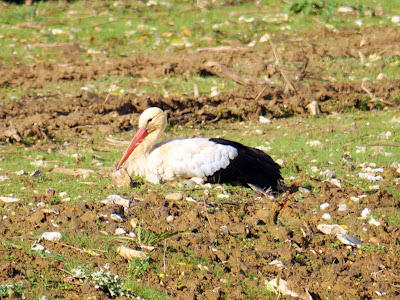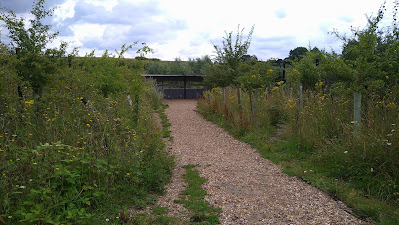Beddington Farmlands
I used to work near the Beddington Farmlands site and it wasn't the most popular neighbour among my colleagues but I found it fascinating. I got some glimpses of wildlife through the fencing - families of foxes and birds including little egrets, shovelers and teal (ducks).
 |
| Fox at the Beddington Lane side of the Farmlands, May 2012 |
From the Hackbridge end, with my camera at full zoom I was able to spot wetland birds like shoveler ducks and lapwings.
 |
| Lapwings and shovelers, March 2014 |
Although technically in the borough of Sutton, Beddington Farmlands has been an important site for Croydon for over 160 years. The sewage works here originated as a sewage processing site for the Croydon Board of Health and it still plays a big part in our sewage and waste disposal services. It's also close to Croydon - there are views of the town centre and Purley Way area from the new bird hides installed a couple of years ago.
 |
| Ikea towers and new buildings in Croydon town centre, Nov 2020 |
The variety of habitats on the site supports thousands of birds and a variety of species not found many places in the London area.
Notably, in 2020 a white stork turned up and made the site its home for a number of months.
 |
| White stork and grey heron, Nov 2020 |
 |
| View towards incinerator, Nov 2020 |
It is a good example of how essential human infrastructure can also provide homes for nature. I know the management of the site hasn't been perfect and the incinerator is very controversial. However, I think by restricting public access to the site it has helped the wildlife. In neighbouring Beddington Park, some of the more reclusive species are put off by the presence of humans and dogs, especially when they enter the water. There is a detailed plan posted in one of the hides for the development of public access to parts of the site but I don't know how much this has been delayed by Covid.
I visited Beddington Farmlands twice in the summer of 2013, once on an organised bird walk and once when I got to tag along to a bird ringing session. This was before the incinerator had been finished. I was shocked by the number of plastic bags that were blown against the fence of the landfill area.
 |
| Landfill fence, June 2013 |
Back then there was little visibility of the lakes from the footpath, just glimpses through the fencing or from the bridge at Hackbridge. Now the path is much wider and has three hides on it.
It's possible to walk between Beddington Park and Mitcham Common along the Farmlands path. It's also accessible from Mile Road bridge near Hackbridge station (click for map). It's suitable for cycling but I recommend walking as you will see more wildlife. I tried cycling it in 2012 but it was so overgrown I got scratched up by brambles. Thankfully the path is much wider now.
With the lockdowns meaning I couldn't visit sites like the London Wetland Centre at Barnes, Beddington Farmlands became particularly important. Its open air hides remained accessible throughout. I'm grateful for the hides but not sure who thought crunchy gravel was a good flooring material for them.
On my most recent visit, a large area of disturbed earth looked quite ugly to me but it was proving popular with a large flock of starlings.
There's at least one resident kestrel who can often be seen near the hide closest to Beddington Park.
 |
| Kestrel, Nov 2020 |
I recommend visiting the site if you have any interest in birds or in seeing the interaction of wildlife with human activities. Take binoculars as the birds are mostly quite far from the hides. There are no facilities on the site except the hides which are basic shelters but nearby Hackbridge has shops and a train station and Beddington Park has car parks, a café and pub/restaurant.










Comments
Post a Comment